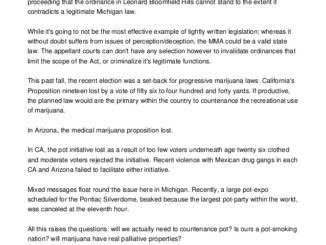
BACKGROUND
To date, medical marijuana is legalized in the United States in 30 states including the following:
Alaska, Arizona, Arkansas, California, Colorado, Connectiut, Delaware, DC, Florida, Hawaii, Illinois, Maine, Maryland, Massachusets, Michigan, Minnesota, Montana, Nevada, New Hamshire, New Jersey, New Mexico, New York, North Dakota, Ohio, Oregon, Pennsylvania, Rhode Island, Vermont, Washington and West Virgina.
Each of these states have their own regulations and guidelines regarding use and qualifications.
Here in Florida, the Medical Marijuana Legalization Initiative, also known as Amendment 2, passed on November 8, 2016 for qualified patients under the supervision of a qualified and licensed marijuana doctor. Furthermore, this amendment passed with a total of 6,518,919 (71.32%) YES votes and 2,621,845 (28.68%) NO votes.
The federal government has classified Marijuana as a Schedule 1 drug making it illegal for doctors to prescribe marijuana to their patients. These marijuana doctors can only make recommendations for medical cannabis in compliance with the state law which can be valid up to 1 year. Patients cannot go to a pharmacy to fill a prescription for medical marijuana.
Under strict regulations, medical marijuana doctors are prohibited to be affiliated with any medical cannabis distributors or dispensaries.
Only certain patients with “debilitating ailments” are afforded legal protection under this amendment. Ailments classified under its provision include PTSD (Post Traumatic Stress Disorder), Chronic muscle spasms, Multiple Sclerosis, Seizures, Epilepsy, Glaucoma, Crohn’s Disease, Cancer, HIV/Aids, ALS (Amyotrophic lateral Sclerosis or Lou Gehrig’s Disease) and Parkinson’s Disease.
Although the above ailments were indicated as “primary debilitating conditions”, under this provision, Amendment 2 also indicated: “or any other ailment/condition of similar severity/symptoms, as determined by a physician’s opinion that the medical use of marijuana would outweigh any potential health risks”.
There are currently about 56 known and listed marijuana doctors on Florida.
More information and specifics regarding this topic can also be obtained from the website of the Florida Department of Health (http://www.floridahealth.gov) on how to become a medical marijuana patient in Florida. More in-depth information about Amendment 2 can also be found here.
PARKINSON’S DISEASE
A few months ago, I came across a video on Facebook about a man with Parkinson’s disease who was given a shot of medical cannabis. The before and after videos were quite impressive. Before the treatment, you can see this man’s significant tremors, stuttering and abnormal posturing. The after video showed a very different person. His speech was intelligible and audible. He had no stuttering, tremors and he showed very controlled movements. This man was walking and talking as any normal person would. He also shared how it has improved his quality of life.
As a physical therapist with exposure to various cultural backgrounds, I personally have mixed feelings about medical cannabis. As a healthcare professional however, it is quite an epiphany to witness one of my patient’s significant change with medical cannabis use.
Mr. J.L. with Parkinson’s Disease
For over five years, Mr. J.L. has been coming to me for physical therapy treatment off and on for problems brought on by his Parkinson’s disease. Knowing the progressive nature of the disease, I watched this gentle soul deal with the effects of this debilitating affliction. His primary physician would refer him for treatment when he starts to develop weakness, rigidity, tremors and most of all, balance problems where he reported falls at home.
We would see him for a period of about six to eight weeks each time. We worked on improving his coordination, strength, flexibility and balance for the primary purpose of keeping him safe and self sufficient at home as he lives alone. It is also to keep from falling which predisposes him to more severe injuries and complications.
The Change
About a few weeks ago, he came to the office to schedule for Physical Therapy as he was referred again by his doctor. Having worked with this patient through the years, I was trying to figure out what changed in him. I looked, and observed intently as I did my initial evaluation. He may have noticed the curiosity that was nagging me because he gave me a knowing smile. No longer able to contain my curiosity, I asked him: “Mr. J, what have you been up to?” Mr. J just laughed and asked me why the curiosity!
Well, it finally dawned on me that Mr. J. barely had no tremors on his right hand where he used to exhibit the typical pin-rolling tremors of this disease. His neck was aligned and was not shifted towards the right side. Furthermore, his speech was clearer! Another thing that struck me was that he was walking better. Not great, but he was able to turn around without having to shuffle which I have seen him do for years.
He finally shared with me that he started taking medical cannabis for over a month as recommended by his neurologist. A friend of his apparently mentioned to him a video on Facebook about a man with severe Parkinson’s disease. This man received a shot of medical cannabis and the change was visible after only a few minutes. This apparently prompted him to consult with his primary physician and then his neurologist.
The change I have seen with Mr. J after only over a month of being on medical cannabis is significant. His speech improved. His voice deeper and more audible. He had no stuttering and he had more control of his right hand from almost a non-existent tremor. He is also standing straighter. His balance and coordination have improved, even more so with the advanced balance retraining he is currently receiving.
During his therapy sessions, Mr. J could bounce a ball on the floor faster with better accuracy. We saw him throw and catch a ball in standing without anyone holding on to him. We used to have somebody stand behind and hold him as he had slow reactions and reflexive responses. His walking also improved. Just months ago, he would drag his right foot and walked with very short shuffling steps. He would lose his balance with the slightest attempt to turn around or lift his leg higher to stand on one leg.
These seemingly subtle changes in him for just about over a month of using medical cannabis has made a difference in his life. He shared that he feels more relaxed and is less anxious about falling. He can do simple house chores with more confidence and he is able to tolerate more advanced therapeutic exercises during his physical therapy sessions. He does not feel as tired and is able to do more tasks throughout the day.
Mr. J is still on this journey and wanted to share this experience and for me to tell his story. Knowing him and his background, he is not the type of person who would take marijuana indiscriminately for mere recreation and self indulgence.
About Mr. J.L.
Mr. J is originally from Central New York and has moved to Florida. He was diagnosed with Parkinson’s Disease approximately seven (7) years ago. He used to be a designer for a very prestigious Syracuse China manufacturer whose customers include the White House, 5 star hotels and prestigious restaurants. He also was a member of a Barber Shop Quartet as a tenor for the SPEBSQSA (Society for the Preservation and Encouragement of Barber Shop Quartet Singing in America) and has been on several amateur Broadway shows in New York. He was an art teacher to middle school students teaching drawing.
His life changed when he was called to ministry sometime in 1986. He became involved with a healing ministry which he revealed was mostly with people who had tumors. He has traveled abroad to expand his healing ministry. This has garnered so much attention that even the media noticed and did several coverage on his ministry. He is now retired and lives in Palm Bay Florida.
It is a privilege to know this special person who has done so much during his younger days. He has dedicated so much time and commitment to helping others. I deeply appreciate the humanitarian service Mr. J has rendered and how his ministry has touched so many lives. I consider him another unsung hero of his time.
His willingness to have me share a snippet of his story is a privilege. Moreover, to be able to work with him to further his progress and see his motivation and determination through the years is a very inspiring experience.
Mr. J.L.’s personal battle with Parkinson’s Disease.
Mr. J as he shared, was officially diagnosed with Parkinson’s Disease some seven years ago. He has been under the care of a doctor of Internal Medicine practicing in Palm Bay, Florida.
About Parkinson’s Disease
As described by the Mayo Clinic staff: “Parkinson’s Disease is a Progressive disease of the nervous system that affects movement. It develops gradually, sometimes with a barely noticeable tremor in just one hand. But while tremor may be the well-known sign of Parkinson’s disease, the disorder also commonly causes stiffness or slowing of movement.”
Subsequent effects of the disease include the following: expressionless face also known as masked facies or hypomimia and decline in speech quality that can be slurred, soft, even stuttering. These are very common in patients I have worked with. A patient’s walking ability is also affected. There is loss of arm swing from trunk rigidity, stiffness and shuffling steps from resulting incoordination.
Unfortunately, this disease is progressive and current medications are aimed to improve the symptoms but not necessarily a cure.
There are currently many ongoing researches for cure including surgery to regulate certain regions of the brain and electrostimulation.
Still, there is no standard treatment for cure at this time, as per the National Parkinson Foundation.
Additionally, medication, lifestyle modification, exercise and rest are recommended.
Medications Prescribed
Current medications prescribed include the following: Carbidopa-Levodopa, Carbidopa-Levodopa infusion, Dopamine Agonists, MAO-B inhibitors, Catechol-O-Methyltransferase (COMT Inhibitors), Anticholinergics and Amantadine. -Source: The Mayo Clinic Organization
Parkinsons and Surgery
Deep Brain Stimulation (DBS) ia procedure where electrodes are implanted in specific areas of the brain with a generator implanted in the chest area near the collarbone which sends out impulses to the brain aimed at reducing the symptoms. It is not a cure however and there are many risks and side effects involved. Both the medication and DBS will not halt the progression of the disease.
Parkinson’s and Physical Therapy
Physical Therapists get to work with these type of patients during the different stages of the disease. This is primarily because of the functional decline resulting from incoordination, dyskinesias (involuntary movements) and rigidity which makes purposeful and spontaneous movements very tedious.
These problems can make even the most basic functions as feeding, grooming and toileting very difficult. Walking becomes very unsteady. Shuffling gait is very common where it is difficult for them to make the first step (because of bradykinesia – very slow movement) but once they go, it is also very difficult to stop. Many of these patients are at a high risk for falling and a large number during the advanced stages become fully dependent for care.
When referred to Physical Therapy, patient education regarding appropriate exercises, movement strategies, task modification, gait training and fall prevention strategies are a part of the overall plan of care and functional intervention. They are also often referred to Speech Therapy for speech and feeding problems, and to Occupational Therapy for basic self care and hand or upper extremity functions.
Mr. J’s Battle
I first worked with Mr. J about 5 years ago. Although he was not on the advanced stages of the disease at that time, he already manifested the primary visible symptoms of the disease: Hand and neck tremors, masked facies, rigidity and significant incoordination. He walked very slow, was shuffling and took a long time walking even from room to room as he was unable to make quick turns. When he does turn, he tends to lose his balance and fall. His reflexes were very slow. He could hardly catch a ball or bounce it. His speech was slurred, barely audible and he had a stutter. He had difficulty getting up and down simple curbs and stairs. He had fallen a few times from balance issues.
Mr. J persevered with the physical therapy program and was always very motivated. For each of the episodes that he was referred to us through the years, he always showed improvement and always followed through with the specific exercise program we prescribed. Due to the progressive nature of the disease however, he would have a physical decline and we had to work with him again.
He shared the story of how he first noticed the change in him from Parkinson’s. Foremost he mentioned was when he was teaching drawing to middle school students in his art class in New York. He said that he was progressively having difficulty drawing and using his right hand as he had developed tremors. The rest followed including a change in his facial expression, rigidity and feeling stiff all the time.This became progressively worse through the years until his move to Florida.
Once under the care of an internist, he was prescribed Sinemet and other medications which he had taken through the years.
The last time I saw him for treatment was in early 2016 where he had significant tremors on his right hand and an involuntary twitching in his neck. His masked facies had progressed, his face almost droopy and he was walking with so much shuffling and difficulty. He was barely able to move one foot in front of the other. He also reported of falls because of worsening balance problems.
This was why when I saw him in March of this year, I saw the significant change in him which he attributed to medical cannabis.
Medical Cannabis: Capsules and Gummies
He further shared his story. Upon hearing about the potential benefits of medical cannabis for Parkinson’s disease, he consulted with his primary physician who directed him for further consult with his neurologist. His neurologist recommended trying medical cannabis due to the advancing nature of his Parkinson’s disease.
Mr. J then got started on medical cannabis capsules where he said it contained about 30 pieces of 25 mg capsules. This costed him about $80 or so including shipping. With his shipment came a sample pack of the gummies version of about 5 gummies in a pack. The capsules were bitter, according to him and he took 1 capsule daily.
He added that after taking the first capsule ever, he felt so relaxed and calm. He could move around, get in and out of bed easier, get in and out of his chair better. He also noticed that his tremors were much lesser that first time.
Mr. J stated that he liked the cannabis gummies better as it tasted much like candy and was tastier than the capsules. Even more so, the effect of the gummies seemed much faster than that of the capsules and was much cheaper. The capsules per piece costed about $3 each and the gummies would amount to about $1 a piece he added.
So as to mimic the effect of the gummies, Mr. J said he tried melting the capsule under his tongue to take off the edge of its bitterness. He also chewed regular gummy bear candy. This worked for him.
To date, Mr. J continues with physical therapy where we see him better able to tolerate and execute high level balance training tasks that he was unable to do so before. He has very little to no tremor on his right hand, he no longer exhibits the twitching on his neck, and his reflexes improved. I see this by his ability to make a turn and not lose his balance. We do not have to hold him while he catches, throws or bounces a ball to improve his protective righting reflexes necessary for him not to fall. he can lift his feet higher when walking and his shuffling is so much lesser.
Still aware of the progressive nature of this disease, it is just inspiring to see this very soft-spoken, kind-hearted, intelligent and talented individual overcome simple daily functional obstacles brought about by this debilitating and irreversible disease.
For the population afflicted with debilitating diseases, a day to day victory of being able to move about and perform tasks that seem so trivial to most of us, is a blessing.
Legalizing medical marijuana currently is, and will be an ongoing battle in congress. We all have varying stands and strong opinions about this issue. Researches are ongoing about its pros and cons. I foresee more awareness of its existence as an alternative treatment to various diseases who do not respond to conventional medicine and treatment.
As a medical professional however, it is just fulfilling to be able to witness the functional changes in Mr. J., how he is able to stay independent and self sufficient despite his impairment.
I am currently working on finding an individual who can share with me the negative effects of medical marijuana as well. I would like to hear from you and be able to share your journey and experience as well, anonymously, of course.
Please reach out to me if you have something to share.
My greetings for a wonderful day and until my next article!
Proudly WWW.PONIREVO.COM
by Lovena Suson



